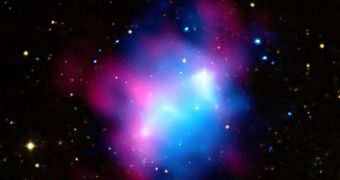In a new research, a team of experts discovered that collisions between massive galactic clusters can trigger the formation of incredibly large and beautiful halos, which can be observed in the radio portion of the electromagnetic spectrum.
Studying the mergers in such manners may in the future yield additional insight into the processes and phenomena taking place inside the cosmic structures.
The study team focused its attention on 32 cosmic clusters, including the one called Abell 1758. This particular structure is located some 3.2 billion light-years away from our planet.
This vast distance allowed astronomers and astrophysicists to get a clear picture of how the galaxies within the cluster interact. They determined that two smaller cluster within the large one were colliding.
Around these structures, telescopes identified impressive radio halos, which could easily be resolved. How these radio emissions are produced is still largely a mystery.
In the new image, the blue portions of the photo are derived from data produced by the NASA Chandra X-ray Observatory, one of the American space agency's most important and complex telescopes.
The instrument shows that large amounts of hot gas exist in the cluster. Its readings were combined with some obtained by the India-based Giant Meterwave Radio Telescope (GMRT), which produced the pink colors in this photo.
The Meterwave instrument reveals the existence of large magnetic fields inside the cluster, which exist alongside ultra-relativistic particles. Together, these two cause the radio halos, at least in part.
Additionally, experts also introduced gold-colored light in the image. These data were collected in optical wavelengths, by teams handling the Digitized Sky Survey initiative.
The new work has important implications. One of them is the fact that galactic cluster mergers are creating “turbulences” around them, which accelerate electrons in very much the same way a particle accelerator back on Earth does.
Another major finding was establishing that only galaxies which are still forming exhibit the radio halos. All other similar structures do not show the same trait.
Over the past years, combining data obtained from various telescopes into single, high-detail images has become common practice.
This habit allows experts to keep an eye on radiation emissions in all sections of the electromagnetic spectrum, Space Fellowship reports.

 14 DAY TRIAL //
14 DAY TRIAL //